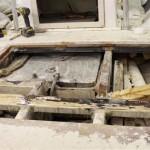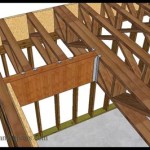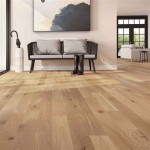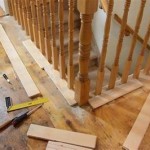Do You Need Waterproof Flooring In Your Kitchen?
The kitchen, often considered the heart of the home, is a hub of activity. From meal preparation and cooking to casual dining and social gatherings, the kitchen floor is exposed to various challenges. These include spills of water, oil, and other liquids; dropped food; and the general wear and tear of daily foot traffic. Consequently, selecting the correct flooring material is crucial, and the question of whether waterproof flooring is necessary in the kitchen deserves careful consideration.
Traditional flooring options, such as hardwood and laminate, are susceptible to water damage if exposed for prolonged periods. Water can seep into the seams and layers, causing swelling, warping, and ultimately, requiring costly repairs or replacement. Conversely, waterproof flooring options provide a barrier against moisture intrusion, offering greater protection and peace of mind in a high-risk environment like the kitchen. This article explores the benefits and considerations of waterproof flooring in the kitchen, aiming to provide a comprehensive understanding of whether it's the right choice for your specific needs.
Understanding the Risks of Water Damage in the Kitchen
The kitchen environment presents numerous opportunities for water exposure. Leaky appliances, overflowing sinks, accidental spills during cooking or cleaning, and even moisture wicking up from the subfloor can all contribute to water damage. Understanding these risks is the first step in determining whether waterproof flooring is a necessary investment.
Consider the frequency and severity of potential spills. Households with young children or individuals prone to accidents may experience a higher incidence of spills than others. Similarly, the type of cooking done in the kitchen can influence the likelihood of spills. Frequent use of liquids, such as sauces, soups, and boiling water, elevates the risk. Furthermore, the presence of appliances like dishwashers and refrigerators, which are prone to leaks, further increases the potential for water damage.
Beyond surface spills, the subfloor underneath the visible flooring can also be a source of moisture. In older homes, or those with inadequate ventilation, moisture can rise from the ground and permeate the subfloor. This moisture can then transfer to the flooring material, leading to mold growth, structural damage, and unhealthy living conditions. Therefore, even if surface spills are minimal, considering the potential for subfloor moisture is crucial when selecting kitchen flooring.
The impact of water damage extends beyond aesthetic concerns. Mold growth, a common consequence of water intrusion, can trigger allergies, asthma, and other respiratory problems. Furthermore, structural damage to the subfloor can weaken the integrity of the floor, potentially leading to costly repairs. In severe cases, water damage can compromise the structural integrity of the entire house.
Therefore, a thorough assessment of the potential risks of water damage in your kitchen is essential before making a flooring decision. Factors to consider include the frequency and severity of spills, the presence of leak-prone appliances, and the potential for subfloor moisture. A prudent approach involves weighing these risks against the cost and benefits of different flooring options, including waterproof alternatives.
Exploring Waterproof Flooring Options for the Kitchen
Several flooring options are specifically designed to resist water damage, offering varying degrees of protection, aesthetics, and cost-effectiveness. Understanding the characteristics of these options allows for a more informed decision when choosing the ideal kitchen flooring.
Luxury Vinyl Tile (LVT) and Luxury Vinyl Plank (LVP) are popular choices for kitchens due to their excellent water resistance, durability, and aesthetic versatility. These materials are constructed with multiple layers, including a waterproof core and a durable wear layer that protects against scratches, stains, and dents. LVT and LVP are available in a wide range of styles, mimicking the look of natural stone, wood, and tile. These materials are relatively easy to install and maintain, making them a practical and cost-effective option for many homeowners.
Sheet Vinyl flooring provides a seamless, waterproof surface, minimizing the risk of water seeping through seams and joints. This type of flooring is particularly well-suited for kitchens where spills are frequent or where a continuous, uninterrupted surface is desired. Sheet vinyl is available in various patterns and colors, offering designers flexibility in achieving their desired aesthetic. While sheet vinyl is durable and easy to clean, it can be susceptible to scratches and dents. Thicker, higher-quality sheet vinyl offers increased resistance to these types of damage.
Tile flooring, particularly ceramic and porcelain tile, is inherently waterproof and highly durable. Tile is resistant to stains, scratches, and heat, making it an excellent choice for high-traffic areas like kitchens. Tile is available in a vast array of sizes, shapes, colors, and patterns, allowing designers to create unique and personalized spaces. Grout lines, however, are porous and can absorb moisture if not properly sealed. Regular sealing of grout lines is essential to maintain the waterproof integrity of the tile floor.
Engineered hardwood flooring offers a compromise between the aesthetic appeal of hardwood and improved water resistance. Engineered hardwood consists of a thin layer of real hardwood veneer bonded to a core of plywood or other composite material. While not entirely waterproof, the multi-layered construction of engineered hardwood provides greater stability and resistance to moisture than solid hardwood. However, prolonged exposure to water can still cause damage to engineered hardwood.
When selecting a waterproof flooring option, it's crucial to consider the overall cost, including materials, installation, and maintenance. LVT and LVP are generally more affordable than tile or engineered hardwood. Installation costs can vary depending on the complexity of the project and the skill of the installer. Maintenance requirements differ among the various options. Sheet vinyl and tile are relatively easy to clean, while engineered hardwood may require specialized cleaning products and techniques.
Evaluating the Cost vs. Benefits of Waterproof Flooring
The decision to invest in waterproof flooring for the kitchen requires a careful evaluation of the associated costs and benefits. While waterproof flooring typically comes with a higher upfront price tag than non-waterproof alternatives, the long-term benefits can outweigh the initial investment.
The primary benefit of waterproof flooring is the protection it provides against water damage. This protection can save homeowners significant amounts of money in the long run by preventing costly repairs or replacements due to water-related issues. A single major water leak can necessitate the replacement of an entire floor, along with potential subfloor repairs. Waterproof flooring mitigates this risk, offering peace of mind and financial security.
Beyond preventing water damage, waterproof flooring also offers enhanced durability and resistance to stains, scratches, and dents. These qualities contribute to a longer lifespan, reducing the frequency of floor replacements. In high-traffic areas like kitchens, this durability is particularly valuable, ensuring that the floor maintains its aesthetic appeal for years to come.
The ease of maintenance associated with waterproof flooring is another significant benefit. Most waterproof flooring options are easy to clean with simple household cleaners, requiring minimal effort to keep them looking their best. This is particularly advantageous in kitchens, where spills and messes are commonplace.
Conversely, the initial cost of waterproof flooring can be a deterrent for some homeowners. LVT, LVP, and tile typically cost more per square foot than laminate or standard vinyl flooring. Installation costs can also be higher, particularly for complex installations requiring professional expertise. However, when considering the long-term costs associated with potential water damage, the upfront investment in waterproof flooring may prove to be a more cost-effective solution.
In addition to the financial considerations, aesthetics and style preferences also play a crucial role in the decision-making process. While waterproof flooring options have expanded significantly in recent years, offering a wide range of styles and designs, some homeowners may prefer the look and feel of natural materials like hardwood. In such cases, carefully weighing the aesthetic benefits of hardwood against the potential risks of water damage is crucial.
Ultimately, the decision of whether to invest in waterproof flooring for the kitchen depends on individual circumstances and priorities. A thorough assessment of the risks of water damage, a careful evaluation of the available flooring options, and a realistic comparison of costs and benefits are essential steps in making an informed decision that aligns with your needs and budget.

The Best Waterproof Flooring Options Inc

6 Ideas For Waterproof Kitchen Flooring Lx Hausys

Best Kitchen Flooring Options 2024 Guide Forbes Home

What Is Waterproof Flooring

The Best Waterproof Flooring Options Inc

Waterproof Laminate For Your Kitchen Bathroom Is It The Best Choice Flooring Direct

Best Waterproof Flooring Options For Your Kitchen Ultimate Guide

Luxury Wpc Waterproof Flooring For Kitchen Remodeling Slcc

Does Your Kitchen Required A Waterproof Flooring

Kitchen Flooring Trends Waterproof Napolis
Related Posts








